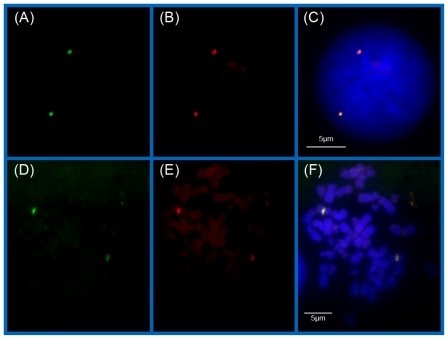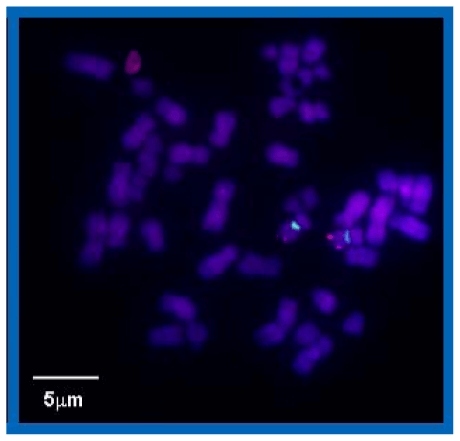COMBinatorial Oligo FISH
COMBO-FISH Technology
FISH can mark DNA sequences from entire chromosomes to centromeres or telomeres and other subchromosomal regions to visualize individual genes with high specificity and sensitivity (multicolor). Different FISH variants have been used in biological or medical diagnostic numbers (for example, gene copy number changes) or structural (for example, translocations) to detect chromosomal or genetic changes. In the past ten years, the genome sequence database of many species has become more and more perfect, and a technology that is different from the traditional FISH COMBO-FISH (COMBinatorial Oligo FISH) has gradually developed. The probe design of COMBO-FISH is based on the bioinformatics search in the sequence database, which can be performed on any species that has been sequenced so far. COMBO-FISH allows precise and focused fluorescent labeling of chromatin domains in the nucleus by a combination of computer-selected fluorescently labeled short DNA or PNA probes. This co-localization probe set hybridizes to a defined genomic region and generates a locus-specific fluorescent signal, which is specifically labeled about 50-250 kb with a typical probe set of about 20-40 segments. In addition, through the high-purine or high-pyrimidine oligo probe set design strategy, a probe set for double helix or triple helix hybridization can be designed.
 Fig 1. An example of using the PNA COMBO-FISH probe to simultaneously label the centromeric region of chromosome 9. (Müller P, et al. 2010)
Fig 1. An example of using the PNA COMBO-FISH probe to simultaneously label the centromeric region of chromosome 9. (Müller P, et al. 2010)
Probe Design and COMBO-FISH Methodology
Tests based on COMBO-FISH technology are based on custom-made COMBO-FISH oligonucleotide probes. Compared to standard FISH, the small size of COMBO-FISH oligonucleotide probes avoids structural changes in labeled chromatin targets. This allows the study of chromatin microstructure and nanostructure under very mild conditions. This technology has relatively high requirements for the customization of probes, and our probe customization service can be used for this technology, including custom DNA oligonucleotide probes and PNA probes, which customers can choose according to their needs. Compared with DNA probes, PNA probes have a neutral backbone, which can avoid electrostatic repulsion with negatively charged DNA targets and improve binding stability. For some COMBO-FISH in vivo labeling applications, PNA probes are resistant to enzymatic digestion. Our services are customized one-to-one according to customer needs, and we are confident to provide customers with a quick turnaround probe customization solution.
 Fig 2. An example of a two-color experiment using the repetitive centromere 9 PNA COMBO-FISH probe. (Müller P, et al. 2010)
Fig 2. An example of a two-color experiment using the repetitive centromere 9 PNA COMBO-FISH probe. (Müller P, et al. 2010)
Technology Features
COMBO-FISH has several advantages in comparison to standard FISH.
- Any site can be precisely located and specifically labeled. Due to theoretical probe design from sequencing data.
- The omission of the denaturation step of the double-stranded chromatin target. This may allow even specific chromatin domain labeling of important cells.
- Compared with the length of the gene target, the entire sequence length of the probe set for a specific label is very small.
- PNA probes increase the advantages of oligonucleotide probes.
- COMBO-FISH uses high-purine/high-pyrimidine oligonucleotides and complementary high-purine/high-pyrimidine sequences in the complete genomic DNA to form double-stranded (Watson-Crick bonding) and triple-stranded helices (Hoogsteen bonding). This helps distinguish between double-strand COMBO-FISH (DSCF) and triple-strand COMBO FISH (TSCF).
Creative Bioarray provides oligonucleotide probe design and customization services. This customized probe set can better assist customers in the study of chromatin microstructure and nanostructure. Our technical service is a fully customized service. If you are interested in our service, please contact us for cooperation. We look forward to cooperating with you in the near future.
References
- Müller P, Schmitt E, Jacob A, et al. COMBO-FISH enables high precision localization microscopy as a prerequisite for nanostructure analysis of genome loci[J]. International journal of molecular sciences, 2010, 11(10): 4094-4105.
- Schmitt E, Schwarz-Finsterle J, Stein S, et al. COMBinatorial Oligo FISH: directed labeling of specific genome domains in differentially fixed cell material and live cells[M]//Fluorescence in situ Hybridization (FISH). Humana Press, Totowa, NJ, 2010: 185-202.
All products and services on this website are only suitable for non-medical purposes.


 Fig 1. An example of using the PNA COMBO-FISH probe to simultaneously label the centromeric region of chromosome 9. (Müller P, et al. 2010)
Fig 1. An example of using the PNA COMBO-FISH probe to simultaneously label the centromeric region of chromosome 9. (Müller P, et al. 2010) Fig 2. An example of a two-color experiment using the repetitive centromere 9 PNA COMBO-FISH probe. (Müller P, et al. 2010)
Fig 2. An example of a two-color experiment using the repetitive centromere 9 PNA COMBO-FISH probe. (Müller P, et al. 2010)


